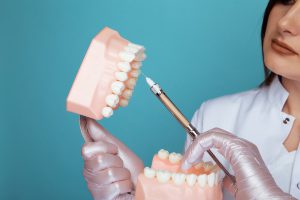If you have a scheduled dental appointment for treatments such as fillings, veneers, dental crowns, dental implants or pretty much anything more complex than professional tooth cleaning, the chances are that you will probably be under some sort of anaesthetic. Did you know that anaesthesia has been around for more than a hundred years? The first anaesthetic in the history of modern medicine was used back in 1846 at a General Hospital in Boston by Dr William Morton (who was a dentist) and John Warren (surgeon). Before that doctors merely used to offer alcohol, opium or other unorthodox means in attempts to numb their patients’ pain.
Nowadays, sedation dentists use it not only to manage physical pain but also to help nervous patients with managing their dental anxiety. Still, if we want to approach this issue holistically, a good dentist will also talk to you beforehand and explain what you can expect from the procedure and ask you to share your concerns.
For more complex dental treatments, such as all-on-4 dental implants, you may want to be put to sleep throughout the whole procedure or if you’re too apprehensive about being unconscious, you can have it done under local anaesthesia. For most nervous patients, it boils down to their level of dental phobia. So let’s have a closer look at the different types of anaesthesia so that you can choose the most appropriate one for yourself.
Contents
What is local anaesthesia?
This type of anaesthetic is done when an injection is inserted into the gum line.
For local injections, the sedation dentists use solutions like Lidocaine, Articaine, and Mepivacaine.
It will not put you to sleep, but rather just numb the area that will be worked on. The initial prick of the needle can be quite unpleasant, but after the drug has started working you should not feel any pain during the procedure whatsoever. Furthermore, if you are a nervous dental patient, you can ask your dental implant dentist to rub some numbing gel beforehand to make the process completely painless.
Dental sedation, when applied locally, has a more short-term lasting effect but does offer fewer complications as opposed to full sedation. They take effect in about 10 minutes and can last up to 60 minutes. One of the most common dental fears is that at some point the anaesthetic’s effect would disappear, however, it’s important to note that it can be always topped up by the dentist, so just make a sign if any painful sensation starts to occur.
Types of local anaesthetic with adrenaline are preferable both for prothetic and surgical injections this is due to their rapid and long-lasting numbing effect.
How does local anaesthesia work?
We experience pain when our nerve receptors are stimulated ( for example when we drill in a tooth), so this signal is then transmitted to the brain which is then registered as a painful experience. So, essentially, what we want to do with the local anaesthesia is cut off this process. We pause the emission of these signals and they can’t reach our brain for a few hours. Still, it’s important to highlight that pain is very important for our body as it serves the purpose of protecting us from any harm, so we don’t want this connection severed permanently.

Types of local sedation
Let’s have a look at the different types of local anaesthesia and their purpose.
Essentially there are 3 variations:
- Topical anaesthesia – applied superficially on the gums, usually used complementary to the other ones
- Infiltrative anaesthesia – mostly used on the upper jaw, designed to eliminate the pain in a single tooth or tooth root
- Nerve block anaesthesia – injected to numb the nerves (not the nerve receptors), you feel numbness in a wider area (cheeck, lips, tongue etc.)
Side effects of local anaesthetics
A detailed medical history is taken before treatment so that our dentists can select the right anaesthetic for you. We will ask you about previous illnesses, allergies or certain medications. The effects of local anaesthesia on the body may include cardiovascular diseases, diabetes, asthma or glaucoma. On this basis, the specialists then decide on the best anaesthetic for you.
No side effects are to be expected after a local anaesthetic. On rare occasions, tiredness or concentration problems can occur after the anaesthetic. Your ability to react may also be restricted under certain circumstances – it is, therefore, advisable not to drive a car or do heavy physical exercise immediately after the treatment.
Other types of anaesthesia
Sedation options for tooth extraction also include monitored anaesthesia care with conscious sedation. What does that mean? It is quite rare for dental implant patients to undergo treatment under full sedation, still, some may undergo extensive facial surgery or have reconstructive procedures done.
The alternatives to a local anaesthetic can be:
- Twilight sedation
- General anaesthesia
Twilight sedation is recommended for anxious patients. It allows them to have both pain and stress-free treatment. During this type of treatment, the patient is in a completely relaxed state and although conscious, they don’t remember a thing.
Naturally, an anesthesiologist is involved in the process – they will administer the dental anaesthesia and monitor the blood pressure, pulse, and ETCO2 (this is the amount of carbon dioxide exhaled – a high mark is a sign of good ventilation). For this type of conscious sedation, there is no need for mechanical ventilation during anaesthesia, so it is by far less invasive for the body as opposed to full sedation.
If I have to designate the top 3 benefits of conscious (twilight) sedation those would be:
- Less stress on the cardiovascular system
- No memory of the treatment
- Recommendable for anxious patients

General anaesthesia is a sedation option for tooth extraction and dental implantation that renders the patient completely unconscious. That way pain and sensitivity during the treatment are completely eliminated. This is total intravenous anaesthesia that patients with extreme dental phobia seek as a number one option. Not only does this procedure ensure that you will not feel any pain during the dental implantation, but it also prevents you from remembering the operation itself.
It makes sense to look for such treatment instead of consistently postponing your visit to the dentist. It is widely known that the longer you avoid visiting the dentist, the more your oral health will deteriorate. There can be various reasons that cause dental patients to experience a mild or severe form of dental phobia.
See the survey results below:

If you need more support on how to overcome dental anxiety you may find this website useful.
What happens when you are heavily sedated?
Full sedation treatments can be appropriate or even required in other cases apart from extreme dental phobia. It can be a suitable option for complex and extended treatments, uncooperative patients (like children for example) or patients that have reported previous allergies to local anaesthesia.
This is why general anaesthetics are a suitable solution because they are characterised by:
- Lack of consciousness
- No pain
- No recollection of the medical treatment
- Muscle relaxation
A consultation with an anesthesiologist is usually necessary before sedation. They review the patient’s medical history, previous dental experience, and medications taken and decide what needs to be done before surgery. It is not advisable to go under general anaesthesia if you:
- Are pregnant
- Have an allergy to benzodiazepines
- Under alcohol intoxication
- Have central nervous system depression
- Have some form of glaucoma
- Have impaired kidney, lung, or liver function
What are the side effects of dental anaesthesia?
Before going into the side effects of general sedation, we should first cover two of the most important recommendations associated with it:
- it is not advisable to eat and drink before sedation
- do not drive 24 hrs after you have undergone treatment.
Possible side effects of being sedated for dentistry work may include acute dizziness, headaches, feeling sick, and itchiness among others.
Bringing it all together
Choosing the best sedation option for dental implant treatments can be a challenging task. Still, your decision should be based on individual medical history and conditions. Nevertheless, it is widely accepted that general anaesthesia is an emergency option due to its associated risks and side effects. Particularly for all-on-4/ all-on-6 dental implant procedures, we rec local anaesthesia.
You should know that even if you struggle with dental anxiety, phobia against dentists may be disturbing, but is not disabling. You can always seek support both from dentists with extensive knowledge and experience in dental implant treatments or talk to other patients who are a part of the community.


